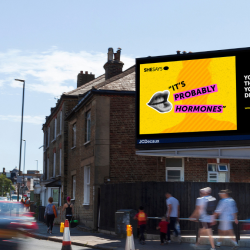Do I think that the Heinz marketers that put out two pieces of communication in the last month meant to refer to Blackface, minstrels and offensive stereotypes around absent black fathers? No. But did they? Absolutely yes.
In 2016, my former boss Fiona McNae gave a TED X talk at Exeter entitled ‘Taking responsibility for being understood’, in which she discussed the gap between what we mean to communicate and how our communication is understood by those we are communicating with. She shared an experience of visiting a radiology department and being directed to a terrifying sounding room called ‘Linear Accelerator 4’, that, upon reflection, could have easily been called a ‘treatment room’ — a choice that would have put her mind and body at ease before embarking on an already daunting treatment journey. It’s this sense of responsibility, this consideration, that the Heinz team, and many marketers, lack.
It’s a foundational premise of semiotics that meaning is not static
We must always be aware of what we are saying, where we are saying it and to whom we are saying it, in order to ensure that our ideas are being communicated as intended. In advertising and marketing, this is a challenge — communications, such as Heinz’ family size pasta sauce, will be seen by tens of thousands of people on the London Underground, in one of the most diverse cities in the world, and everyone who sees it will see it in the context of their own experience. But this is our job and we need to ensure that we are taking responsibility for what we put out into the world. For Heinz, their communications were thoughtless, a product of not thinking about what they were communicating beyond the idea they wanted to, a product of not paying attention to the people they were communicating with, of not taking responsibility for how they are understood; an echo chamber of agreement, out of touch with the world the idea would live in.
The result was two campaigns that perpetuated racist images and stereotypes. When we take responsibility for how we are understood, we can unlock a potency to communications; a shared experience of understanding, rather than a didactic exercise in depiction.
We can use communications to positively clash with our perceptions and cognitive biases that we carry around with us, triggering a reconsideration of cultural beliefs. Bodyform’s campaign ‘It’s Never Just a Period’ depicts the misconceptions, challenges, pain, woe and confusions of the experience of menstruation and the prejudice by which it is viewed by (male) health professionals. Viewing it is to view the experiences of something of which I have no experience, empathetically told in a way that to me (who doesn’t menstruate) feels scary and unjust, and to my sister (who does menstruate) all too familiar. By thinking about their audiences and how they want to be understood, the marketers behind the ad have successfully created a shared experience of understanding that challenges taboos and broadens empathy.
Challenging cultural beliefs, even when intentional, does not always succeed in making communication effective
Take Bumble’s anti-celibacy blunder earlier this year, which condescendingly mocked women’s choice not to date (‘You know full well that a vow of celibacy is not the answer’). The campaign attempted to take a cultural insight around a growing number of women deciding to not date and cheekily communicate in a way that spoke to the context that its customers were navigating — the combination of exhaustion and horror of online dating.
This is where their insight ended, and instead of electing to connect with their users they chose to challenge their choices head-on. This failure to consider how their communication would be understood by a group of people who were experiencing their product in a negative light, speaks to a marketing approach that only cares about talking, not about communicating.
Many marketers, rather than risk making a statement, are opting for something, in some ways, more sinister — silence
2023’s Pride marketing bonanza was characterised by even more vitriol than normal, as the transphobes and homophobes enacted their characteristic histrionics. Bud Light’s partnership with Dylan Mulvaney made Kid Rock shoot some beer (and then drink it a couple of months later) and Target removed Pride merchandise from stores due to concerns over staff safety.
But this year, Pride marketing was eerily quiet. Target reduced the number of stores it sold Pride merchandise in and Bud Light didn’t mention Pride on their socials at all. This hypocrisy undermines any sense of conviction around the brand’s stance and represents a complete opting out of responsibility for how they are communicating.
So next time you are crafting a social post, briefing a creative agency or choosing a picture, stop and think. You can grumble about the woke brigade, and after you have done that, take responsibility:
- Think about what you want to say and what story you want people to experience. What does that story mean to your audience? Have they heard a different version of it already?
- Break your world view, enlist a different perspective and reading of your work, think about your work out of the context in which you intend it, for that is where it will be experienced.
- Amplify voices that counter your narrative of the work, as they are seeing something that you cannot.
- Acknowledge that meaning is not static and that one thing can have more than one meaning. What did your thing mean last year? 20 years ago? 50 years ago? What will it mean tomorrow? And in a year’s time? What does it mean to the most privileged person in the room? What does it mean to the least?
- Are you sharing something with your audience or telling them something? If you are only speaking at them, then you haven’t thought about how you will be understood, only what you want to say.
Featured image: Jacob Rice / Unsplash
































